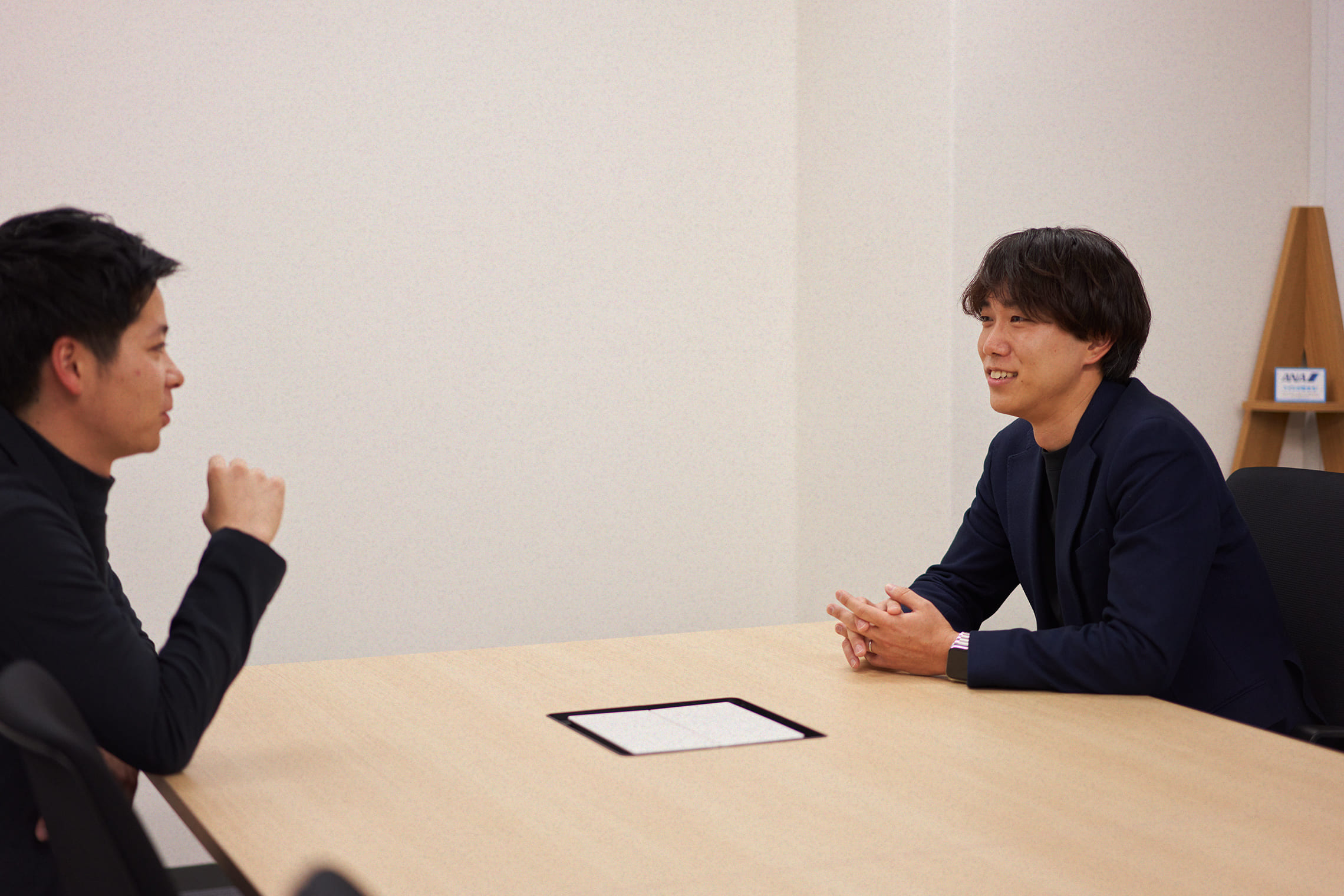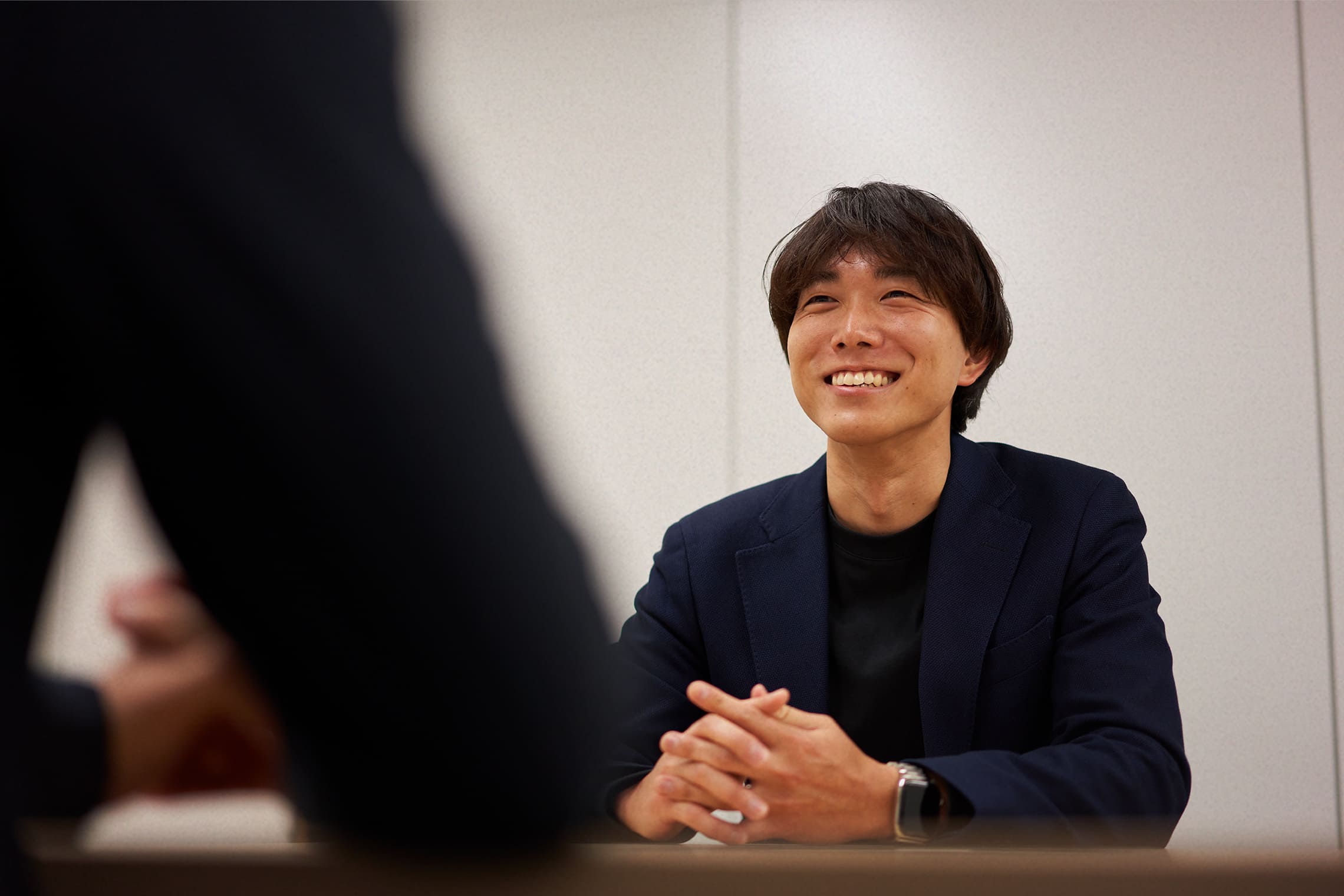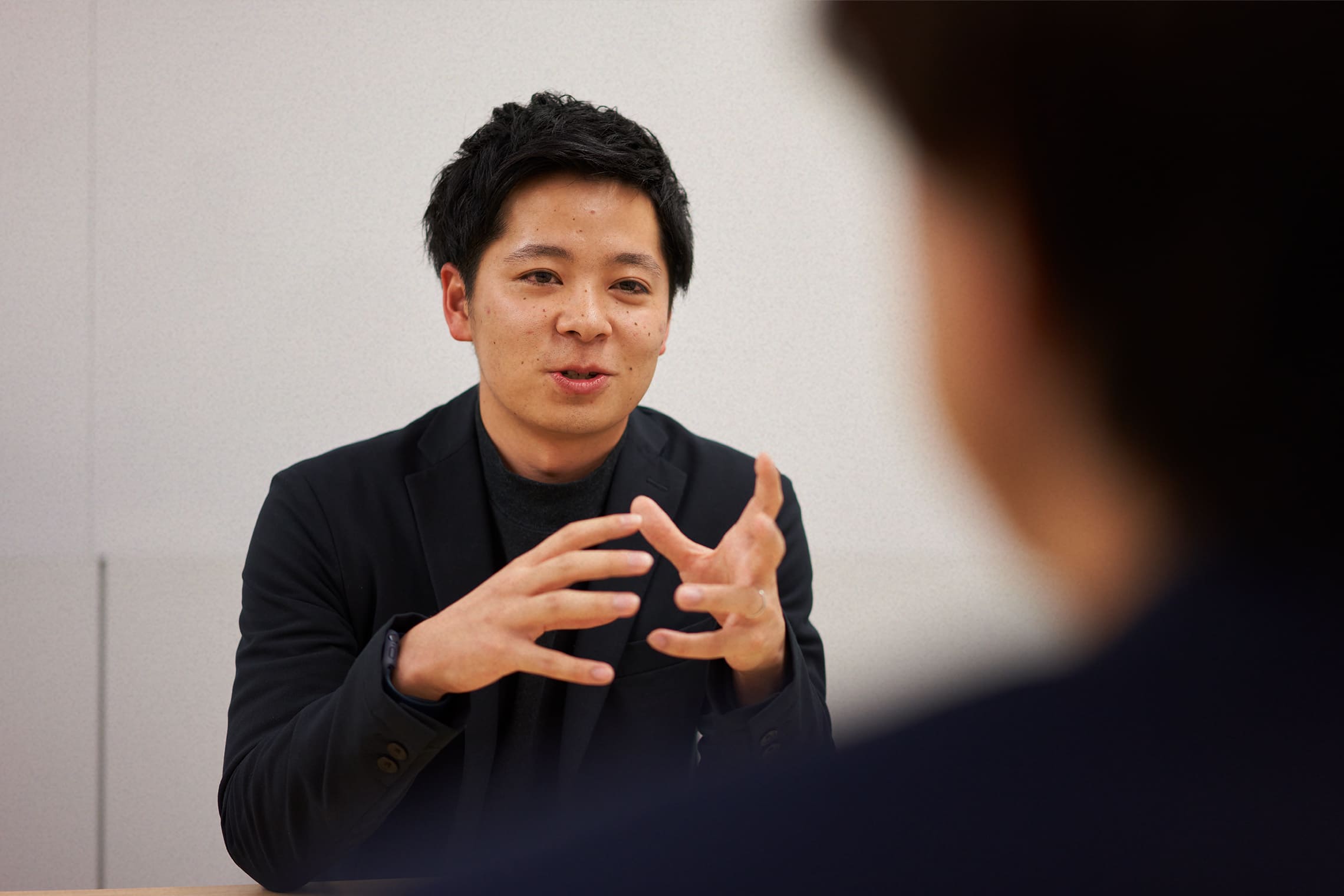Creating a Future in Which People Can Travel Without a Smartphone or Wallet: ANA Digital Gate Uses Biometric Authentication to Transform User Experiences at Tourist Attractions
In 2023, ANA Digital Gate and Hitachi, Ltd. worked together on the Facial Recognition Stamp Rally, a proof of concept (POC) in which participants used facial recognition technology to earn miles at ANA FESTA gift shops. To improve user experiences throughout tourist attractions, ANA Digital Gate plans to integrate biometric authentication-based services not only within the airport, but also with various travel routes, such as airports, car rental companies, and hotels). We spoke with two employees about ANA Digital Gate’s future tourism vision.
Speaker
Head; Business Development Section; Marketing Solution Department; ANA Digital Gate, Inc.
Kuriyu Matsuno
Joined ANA TRADING CO., LTD. in 2015, working in ANA inflight media, new media development, and agency sales, including out of home (OOH) advertising. Transferred to ANA Digital Gate, Inc. in 2020 and led new development and sales for mileage partners, striving to offer more ways for customers to earn ANA and United Airlines miles in their daily lives. Today, he develops new businesses utilizing biometric authentication.
Business Development Section; Marketing Solution Department; ANA Digital Gate, Inc.
Toshihiro Kobayashi
Joined ANA TRADING CO., LTD. in 2018, working in ANA inflight media and ad sales, including airport OOH advertising. Transferred to ANA Digital Gate, Inc. in 2021 and worked in new development and sales for mileage partners, striving to offer more ways for customers to earn ANA and United Airlines miles in their daily lives. Today, he develops new businesses utilizing biometric authentication.
Facial Recognition Stamp Rally with 30,000 participants at airports across Japan
This POC came about when Hitachi was introduced to ANA Digital Gate by DG Financial Technology, one of its shareholders. At that time, ANA Group felt it was not making maximum use of the Group’s customer assets (40 million people), and that it needed to acquire profit from fields outside the airline business due to the COVID-19 pandemic. ANA was planning to expand its economic scope for these reasons.
Although Hitachi possessed cutting-edge biometric authentication technologies, it faced difficulties in commercializing them and promoting these services. Matsuno said that both companies repeatedly conducted POCs in the aim of solving these issues.
“Several years before the facial recognition test, we actually did a POC on biometric authentication utilizing finger veins with Hitachi. Finger vein authentication was used to optimize the check-in process at golf courses. That success demonstrated the potential for Hitachi’s biometric authentication, and we had high expectations for the next project.”
After the biometric authentication test using finger veins, the aforementioned Facial Recognition Stamp Rally tested the facial recognition technology proposed by Hitachi. This plan was launched to see if airport store sales could be increased when more people resumed traveling as the pandemic became less severe.

After inputting their individual information and facial biometric data into their device, participants earned 30 miles each time they stood in front of a camera to check in at 20 shops in 11 airports across Japan, with a maximum of 900 miles. There were approximately 130,000 authentications by approximately 30,000 people during the six-month POC, a much larger number than the originally expected 5,000 participants. Kobayashi described the lessons from the POC and the challenges it revealed.
“It was a meaningful test with absolutely no system errors. We were able to confirm the stability of this authentication technology, even with many more people than we predicted. And since a survey showed 80% of the participants had never visited an ANA FESTA before, I think it was a highly effective way to boost awareness of these stores and store visits.”
“However, the large number of visitors did not increase sales to the level that we hoped. To solve this major challenge, I think we’ll need to take further measures like distributing coupons and suggesting products for individuals, rather than just encouraging them to come to ANA FESTA stores.”

A successful test, thanks to miles and security technologies
As the name of this POC suggests, the important point was that participants earned airline miles. While some enjoyed trying facial recognition, there is no doubt that they were motivated to take part because they wanted to receive miles. It is no exaggeration to say that this incentive is what inspired 30,000 people to participate.
The experiment was a major stepping stone in ANA’s efforts to expand its economic scope. Going forward, Kobayashi said “We will have other options for incentives besides mileage.”
“ANA implements marketing campaigns to enlarge its economic scope. I’m hoping to offer familiar types of points to participants in future campaigns. For example, as a Star Alliance member, ANA could give United Airlines miles to customers. We’ve also used nanaco points in the past. And because some customers don’t have any points, we could offer special benefits like donating to the Japanese Red Cross Society. I look forward to exploring further possibilities for incentives.”
In addition to the incentive of earning miles, Hitachi’s facial recognition technology was certainly behind the POC’s success. Even with many participants, the marketing campaign could not have been sustained during continuous system errors or issues. Matsuno said that ANA Digital Gate chose Hitachi as a partner due to its system stability and solid security technologies.

“Our service is to safely deliver our customers to their destinations. A personal data leak would cause significant damage to the brand. That’s why we are so cautious when it comes to personal information issues, and why we were so attracted to Hitachi’s high-level security technologies.”
“With Hitachi’s patented technology, biometric data obtained from the POC cannot be restored. This ensures privacy, even if the data was ever leaked to an external party, and provides great peace of mind to customers using our services as well.”
Facial recognition can eliminate the need to carry a smartphone
Based on the POC, Kobayashi described the advantages of facial recognition as “ease and simplicity.” Stamp rallies have previously utilized physical paper and stamps, as well as smartphones in more recent years. With facial recognition, the participant just shows their face—they do not have to affix a stamp or take out their smartphone. This makes stamp rallies smoother, both for participants and the companies putting them on.
ANA Digital Gate is thinking about using facial recognition technologies in more situations. Their final vision is “creating a world where you can travel without a smartphone, from the moment you leave home until the time you return.”
“We want to incorporate facial recognition into all procedures, not just at boarding gates, but also when renting a car after arrival. And by partnering with other business operators, tourists could have more enjoyable experiences by using facial recognition to pay at sightseeing facilities, restaurants, and souvenir stores. Facial recognition is merely a technology—its value is demonstrated when utilized in a wide range of situations. I think this extremely versatile technology holds the potential for connections with new businesses we haven’t worked with before.”

Facial recognition also has applications beyond the travel sector; Matsuno said that its true usefulness is demonstrated during disasters. If an earthquake or tsunami occurs, many people must flee with only the clothes on their backs. It becomes extremely difficult for them to confirm their identities if their IDs were destroyed by a landslide or fire. By making it possible to verify an individual’s identity without any documents, biometric authentication can reduce the burden on local governments.
“Implementing facial recognition solely for disaster planning would be difficult, but this would be easier if it was used as a type of marketing support. I hope to proactively partner with local governments, which want to help businesses in their communities attract customers.”
Interest in applications for iris recognition and NFTs
ANA Digital Gate takes a positive view of marketing campaigns utilizing iris recognition, facial recognition, and other cutting-edge technologies. Among these, Matsuno said it is paying particular attention to iris recognition.
“Facial recognition is highly precise, but it doesn’t always work if you’re wearing a hat or mask. However, iris recognition can be used as long as you’re not wearing dark sunglasses, so it’s an easier process for customers. And thanks to technological progress, today’s cameras can identify an individual’s irises from a similar distance as facial recognition. We are paying attention to these increasingly advanced technologies that enable smoother authentication.”
While Matsuno is focusing on authentication technologies, Kobayashi is looking at technologies that provide special benefits for customers. He said that ANA will have to offer perks besides miles, and mentioned that some participants wanted “more exciting benefits” in a survey conducted after the POC.
“Specifically, we’re considering non-fungible token (NFT) technologies. Of course people like earning miles they can use in their daily lives, but I think they’d also appreciate limited-edition items that seem even more special. For instance, I’d like to work with local governments and build structures that encourage people to participate and receive special NFT items in specific regions.”
Creating a world where people can travel empty-handed
This POC was a type of open innovation between two major corporations: the ANA Group and Hitachi. These sorts of projects are quite common today, but some of them do not succeed. Matsuno said that Hitachi’s flexibility is the reason why the two open innovation projects went so well.
“In my opinion, I feel like Japanese companies often spend a lot of time on internal decision-making, which means they can’t respond to minor requests. Hitachi listened earnestly and responded promptly to our requests and the needs of participating stores. I think this attitude is why we were able to accomplish the project so quickly.”
Kobayashi agreed with Matsuno, and said that Hitachi’s stance is a major factor behind these successes. During the two years, one might assume the two companies had a simple relationship of a technology vendor and its client. Kobayashi said “that’s definitely not the case” based on his on-site project experience.
“During the two years we worked together, Hitachi always took part in discussions from an equal footing. Of course their technologies are valuable, but we also received great encouragement from their stance while doing the project together, all the way until the end. Besides the technological aspects, I think the biggest factor behind this success is how Hitachi provided advice throughout the project and responded quickly to our requests.”
Finally, we asked Matsuno about his vision for carrying this POC forward. He replied, “We want to create a world where people can travel without wallets or smartphones.” Kobayashi nodded in agreement.
“If we use physical objects for identity verification and payment, there is always the risk of these items being lost or used for fraudulent transactions. I think we could provide more secure, smarter, hands-free travel experiences through biometric authentication. I want to proactively utilize the latest technologies to create that type of world.”
“At the same time, we’ll have to deal with the issue of helping customers using these advanced technologies. We assisted participants in person when they were unable to register their information before the POC. Based on their comments, our future challenge is how to incorporate user interface and user experience designs that make it possible for anyone to easily and fully utilize these advanced technologies.”